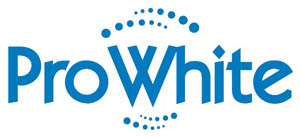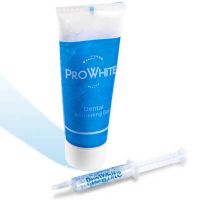Product Comparisons

There are a variety of products and methods on the market today that claim to deliver effective dental whitening. Some of these methods and products work better than others and some do not actually work at all. The important factors in whitening gels are the active ingredients, stabilizing ingredients, viscosity and reactivity. The most effective systems utilize Carbamide Peroxide in a concentration of 10% - 45%. For first-time, tray-based bleaching, formulas containing concentrations of 16% - 22% Carbamide Peroxide yield a great balance of results and comfort. For in-office or experience bleachers, a high-penetration formula of 35% - 45% are very effective. Listed below are the popular methods for at-home dental whitening and their easy-to-measure criterion to compare their effectiveness and value.
Dental Whitening Product Comparisons
| Type of At-Home Whitening System |
Effectiveness | Comfort | Ease of Use | Color Change |
|---|---|---|---|---|
| Premium ThermoForm Tray Systems |
Excellent | Excellent | Excellent | 11 Shade |
| Inferior ThermoForm Tray Systems |
Good | Moderate | Good | 9 Shade |
| Bleaching Click Pens | Good | Excellent | Excellent | 8 Shade |
| Non-moldable Tray Bleaching Systems |
Poor | Moderate | Good | 3 Shade |
| Whitening Strips | Moderate | Poor | Moderate | 2 Shade |
| Whitening Sprays | Poor | Poor | Moderate | <1 Shade |
| Whitening Toothpastes | Moderate | Good | Good | <1 Shade |
There are a variety of dental bleaching gels on the market. Like dental bleaching trays, they all have varying degrees of efficacy. There are several important features of a bleaching gel to look for:
Active Ingredient - Carbamide Peroxide is the ingredient of choice because of its efficacy, safety, stability and shelf-life. This is the ingredient that most dentists prefer. Hydrogen Peroxide is also effective, but has a very short shelf-life and is not widely used for dental bleaching any longer.
Percentage of Active Ingredient - Carbamide Peroxide in the amount of 10% to 44% is used in dental whitening gel. Be sure to use a Carbamide Peroxide of at least 10% for dental bleaching. As a general rule, first-time bleachers should use a 16%-22% formula and begin treatment slowly until tolerance it built for the peroxide base. If a dental whitening formula does not list the percentage of Carbamide Peroxide on its label, assume it is a low powered formula that may be ineffective.
Viscosity - The thickness (or viscosity) of a gel is very important. An effective formula will be a medium to high viscosity (otherwise known as thick or sticky). This helps the gel stay on the teeth where it can do its work. The best gels strike a balance such that a gel can penetrate the pores of the teeth where staining occurs and stay in place long enough to oxidize stains.
Additive Ingredients - Other ingredients can be added to the bleaching formula. Some additive ingredients found are potassium nitrate, fluoride and assorted stabilizers. Our philosophy is to use a pure formula for dental bleaching without unnecessary additives since there are no studies showing the efficacy and long-term effects of such additives in combination with dental bleaching agents. If sensitivities are an issue, it is best to use a stand-alone desensitizing gel or toothpaste containing potassium nitrate.
The most important thing to look for is the active ingredient. You will prefer to use Carbamide Peroxide since it is highly effective and is the bleaching agent of choice in most dental offices. Some gels is made from unstable hydrogen peroxide, Beware, Hydrogen Peroxide has a very short shelf-life and must be stabilized with glycerin, making it less effective and creating more sensitivities. By the time a hydrogen peroxide gel is manufactured, distributed and finally used by the consumer, it may have little or no whitening power left. This is the main reason why Carbamide Peroxide gel is preferred. You can count on it having a shelf-life of up to two years if non-refrigerated or 3-4 years if kept refrigerated.
If a dental whitening system does not contain Carbamide Peroxide, it probably won't give you the results you want. Whitening gels contain from 10% to 45% carbamide peroxide. The most popular strength for tray-based bleaching is 22%. The higher the percentage of carbamide peroxide, the more powerful the formula. Be aware that a high percentage (above 22%) of carbamide peroxide in a tray-based bleaching method may cause unnecessary tooth and gum irritation. Also, buyer beware of any product that is delivered in unmarked containers or syringes with rubber plungers or tip-caps.
The most effective whitening gels are of a medium-high viscosity. In other words it should be thick enough to adhere to the teeth while being able to penetrate the teeth pores and oxidize stains properly.
Another consideration to be given to the formulation of dental bleaching systems is the addition of other active ingredients to the whitening gel. Other products may add flavorings or desensitizers to reduce discomfort of your mouth, gums or teeth during the bleaching process. We elected not to add desensitizers to our formula for very simple reasons. Sensitivity is your body’s way of telling you to reduce the exposure time to the bleaching agent or improper targeting of the gel. If you inhibit this natural warning buzzer, you may unknowingly increase your sensitivity reaction. Also, be aware if fluoride is contained in the whitening gel formula. It is against FDA regulations to formulate a whitening gel with fluoride since the FDA has not approved bleaching formulas containing fluoride.

